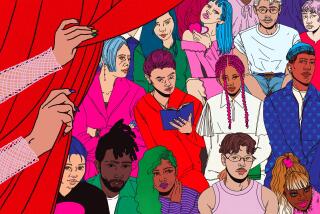Op-Ed: Is masculinity really toxic or is it unfairly under assault?
Is there a war on men and maleness in America?
Last week, a new Gillette razor company ad inspired by the #MeToo campaign was quickly denounced for supposedly slandering men as boorish and abusive.
And earlier this month, the American Psychological Assn. was attacked for its new guidelines on male mental health, which critics said were biased against masculinity.
Both controversies, which are still raging, have pitted “woke” progressives against defenders of traditional manhood. But each side is mired in its own stereotypes while missing the complex realities.
Take the now-infamous Gillette ad, “We Believe,” which offers a parade of men and boys behaving badly as an unseen voice speaks of bullying, sexual harassment and “toxic masculinity.” A chorus of dads chimes in with “Boys will be boys.” Then, after a montage of #MeToo news and a call for change, the ad shifts to “good” men, shown caring for their children, stopping fights, standing up to the bullies and jerks.
Amid cultural upheaval, there is a very real need for constructive messages about maleness.
The ad’s defenders argue that the message is inspiring, not insulting. As the tagline puts it, it’s about “the best men can be.”
Some of the angry responses to the ad were over the top, and yet the detractors have a point. Take the way the ad exhorts men to start doing and saying “the right thing,” and then continues: “Some already are. But some is not enough.” This suggests decent men are a minority while brutes are the norm. What’s more, some of the “toxic” behavior shown is pretty innocuous, such as teenage boys ogling bikini-clad babes on television. (Should we shame girls who drool over cute male pop stars?) The ad also blurs the line between fighting and roughhousing, implicitly condemning the physical play styles more common among boys.
The APA guidelines are a more complicated story. Some of the critiques take aim at things it doesn’t say — such as “toxic masculinity,” a phrase that never appears in the document. The guidelines have also been assailed for claiming that “traditional masculinity — marked by stoicism, competitiveness, dominance and aggression — is, on the whole, harmful.” However, that statement comes not from the guidelines themselves but from an essay about them on the association’s website.
The actual guidelines, nonbinding recommendations to clinical practitioners, are a mixed bag. They acknowledge problems that disproportionately affect men and boys, from poor school performance to suicide, substance abuse and violence. One section extensively discusses the benefits of father involvement, including activities that promote healthy competition.
While the guidelines do take a negative view of many masculine norms, they also emphasize helping patients understand “diverse and healthy” expressions of masculinity. Therapists are urged to be sensitive to typically male attitudes and behaviors (including how depression may manifest itself in men), but are also warned not to assume that all men fit that mold. The text even notes that men can be victims of partner abuse by women and that abused men may be denied help because of stereotypical assumptions.
One problem is that while there is helpful content, it often drips with gender-studies dogma. There’s much talk about “traditional masculinity ideology,” sometimes questionably defined. (Religious traditionalists will be surprised to learn that “traditional masculinity” includes sexual promiscuity.) Sex differences in behavior are treated as entirely the product of socialization, even though the question of nature versus nurture is far from settled. Psychologists working with men and boys are advised to address male “privilege and power.”
This is difficult to square with the empathetic advice in other sections: Try explaining male privilege to a male spousal abuse victim whom the cops are treating as the perpetrator, or a divorced dad struggling to stay afloat and be an involved parent.
Clearly, the would-be reformers of masculinity have their ideological blinders. But many of manhood’s defenders have limitations too. Conservative critics such as National Review columnist David French argue that what the APA calls “masculinity ideology” is simply male nature. Yet, despite some constants (males are more physically aggressive than females in virtually every society and in most mammal species), norms for everything from male emotional expression to aggression levels vary tremendously among cultures and subcultures, just as actual male behavior varies among individuals. Some men are risk-takers or driven achievers; plenty are not. Even if average trends for men and women are linked to biology, that’s no reason to label leadership as “masculine” or caring as “feminine.”
Enter the Fray: First takes on the news of the minute »
Gender norms have undergone dramatic shifts in our time. Work and achievement as well as family are essential goals for both sexes now, and egalitarian marriage and involved fatherhood are widely shared ideals. Unfortunately, along with values that emphasize equal partnership, we have seen the rise of a polarizing feminism that fixates on male misconduct — including such trivial offenses as sitting with knees apart — while ignoring women’s capacity for bad behavior.
Amid cultural upheaval, there is a very real need for constructive messages about maleness — including criticism of genuinely “toxic” attitudes that confuse bullying with manliness or scorn help-seeking as unmanly.
But the key word is “constructive.” The well-intentioned Gillette ad lapses into male-shaming that undercuts its positive point. The APA guidelines get bogged down in ideological shibboleths that contradict their own male-friendly language. If traditionalist claims about male nature don’t capture the reality of many men’s lives, neither do progressive claims about male power. Beyond the stereotypes, the simple truth is that men, like women, are human.
Cathy Young is a contributing editor to Reason magazine and the author of “Ceasefire: Why Women and Men Must Join Forces to Achieve True Equality.”
More to Read
A cure for the common opinion
Get thought-provoking perspectives with our weekly newsletter.
You may occasionally receive promotional content from the Los Angeles Times.










